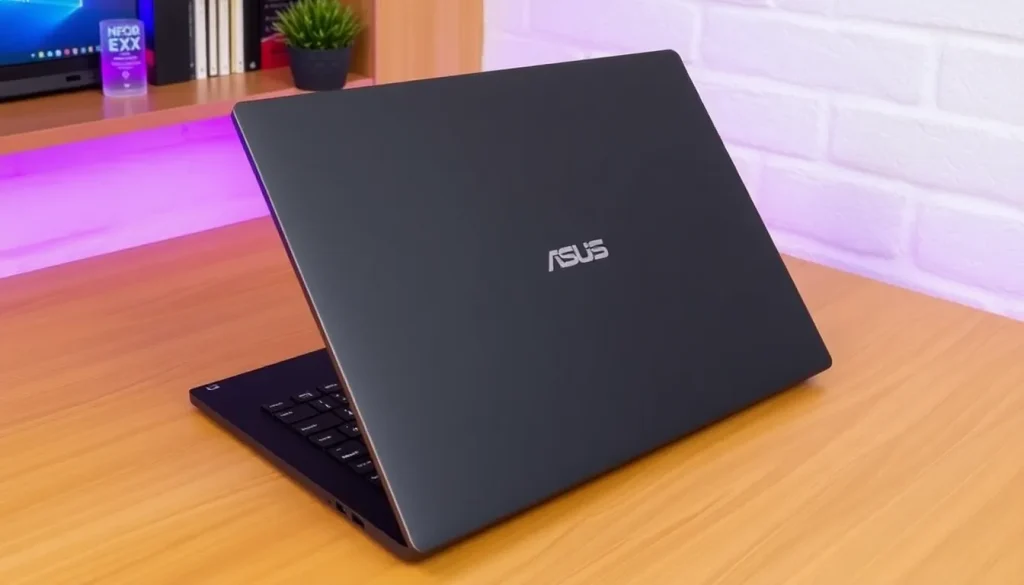ASUS V16 review of the GeForce RTX 5060 laptop model

The ASUS V16 is an entry-level gaming laptop that aims to carve out a niche among budget-conscious consumers, offering a blend of performance and aesthetics. With a design that balances minimalism and functionality, this laptop promises to deliver good performance without breaking the bank. But what exactly does it entail? Let's dive deeper into the specifications and performance of this intriguing device.
- ASUS V16: Overview and Key Features
- Specifications of the ASUS V16
- External Analysis of the ASUS V16: Build Quality and Initial Impressions
- User Experience with the ASUS V16 on Windows 11 and Basic Tasks
- Performance Analysis of the ASUS V16 in Applications and Benchmarks
- Gaming Performance Analysis of the ASUS V16
- Temperature and Power Consumption Analysis
- Frequency Scaling, Latency, and Battery Life
ASUS V16: Overview and Key Features
The ASUS V16 stands out in its class with a configuration that includes the Intel Core Ultra 7 240H, 32 GB of RAM, a 1 TB SSD, and a dedicated GeForce RTX 5060 Laptop. Priced at approximately 1,149 euros, VAT included, this laptop positions itself as one of the most competitive options available today.
But how has ASUS managed to keep the price so attractive while offering these specifications? The answer lies in a few strategic compromises, which we will discuss in detail throughout this analysis.
Specifications of the ASUS V16
Chassis, Dimensions, and Weight
- Constructed from durable plastic.
- Dimensions: 35.70 x 25.07 x 1.80 ~ 2.20 cm.
- Weight: approximately 1.95 kg.
- Military-grade MIL-STD 810H certification for durability.
Display Features
- 89% screen-to-body ratio with an anti-glare finish.
- 16-inch LED IPS panel with a resolution of 1,920 x 1,200 pixels.
- Aspect ratio 16:10, refresh rate of 144 Hz, and Adaptive Sync technology.
- Covers 45% of the NTSC color space.
- Maximum brightness of 300 nits.
- Eye protection technologies to reduce flickering and blue light emissions.
Core Components
- Intel Core Ultra 7 240H processor with 10 cores (6 Performance and 4 Efficiency cores) and 16 threads, capable of reaching up to 5.2 GHz on Performance cores and 4 GHz on Efficiency cores, with 24 MB of L3 cache.
- Integrated Intel GPU with 64 execution units supporting DirectX 12.1.
- Dedicated NVIDIA GeForce RTX 5060 Laptop GPU featuring 3,328 shaders, 104 texture mapping units, 48 raster units, 26 fourth-generation RT cores, 104 fifth-generation tensor cores, a 128-bit bus, and 8 GB of GDDR7 memory operating at 24 Gbps (384 GB/s bandwidth). Its TGP is rated at 75 watts.
- 32 GB (2 x 16 GB) of DDR5 RAM running at 5,600 MT/s.
- 1 TB PCIe Gen4 SSD in x4 mode, with read speeds of up to 6 GB/s.
Cooling System and Battery
- Equipped with two IceCool fans featuring 79 blades each, designed for quieter and lighter operation.
- Two copper heat pipes that effectively transfer heat away from the CPU and GPU.
- Fan blades and rotors constructed from liquid crystal polymer for enhanced performance.
- 63 Wh battery with fast charge capability.
Camera and Audio
- Integrated 1080p webcam with privacy shutter compatible with Windows Hello.
- Front camera features ASUS 3D Noise Reduction technology for improved image quality.
- SonicMaster sound system with dual speakers.
- Integrated microphone with AI noise reduction technology.
Keyboard and Touchpad
- Chiclet keyboard with a 1.5 mm key travel and blue LED backlighting.
- Includes a numerical keypad, maximizing space utilization.
- Touchpad is 40% larger and supports intelligent gestures.
- Touchpad surface is water-repellent and features an anti-fingerprint coating.
Wired and Wireless Connectivity
- Wi-Fi 6 (dual-band 2×2) and Bluetooth 5.3 support.
- One USB 3.2 Gen1 Type-C port with DisplayPort and power delivery support, two USB 3.2 Gen1 Type-A ports, HDMI 2.1 FRL output, a 3.5 mm audio jack, and power input.
Software and Operating System
- Available with or without an operating system; the version with OS includes Windows 11 Home.
- Comes with software such as CapCut, MyASUS, ScreenXpert, and GlideX.
Price and Availability
- Available in three configurations: GeForce RTX 4050 Laptop, GeForce RTX 5060 Laptop, and GeForce RTX 5070 Laptop.
- The analyzed model, featuring the GeForce RTX 5060 Laptop, starts at 1,149 euros.
External Analysis of the ASUS V16: Build Quality and Initial Impressions
The ASUS V16 is built with a focus on providing value for money, which is evident in the materials used. While it is made from plastic, a cost-effective and lightweight material, it is also sturdy and reliable when constructed properly.
Assessing the hinges, screen lid, and keyboard area reveals that ASUS has done a commendable job in ensuring the structural integrity of the ASUS V16. No fragile areas were found, allowing for easy handling even with the screen open and the device powered on.
The ASUS V16 does not fall under the TUF line but instead occupies an independent range, which is noticeable in its design. The laptop boasts a sleek, unobtrusive style that could easily be mistaken for a professional device. The only notable features are the ASUS logo on the lid and the blue LED keyboard lighting.
The keyboard highlights the gaming focus of this machine, with transparent finishes on the "W", "A", "S", "D", and arrow keys. ASUS has effectively utilized the additional space afforded by the 16-inch format, incorporating a numeric keypad.
The touchpad is generously sized and positioned to the left, allowing for more wrist space near the directional keys—an ergonomic choice commonly found in gaming laptops. The touchpad surface is smooth and supports intelligent gestures, enhancing control over the device.
Despite the ASUS V16's 16-inch footprint, it remains compact and lightweight, weighing under two kilograms—an important consideration for those who travel with their laptops.
The screen-to-body ratio is commendable, contributing to the device's overall compactness. ASUS has added a metallic texture to the edges for a touch of premium feel, but the reality is that the chassis is primarily plastic, with its associated pros and cons.
User Experience with the ASUS V16 on Windows 11 and Basic Tasks
It's worth noting that the tested version of the ASUS V16 comes pre-installed with Windows 11, although some models are available without an operating system to reduce costs, requiring users to install it themselves.
Windows 11 operates smoothly on the ASUS V16, handling tasks such as text editing, web browsing, multitasking, and light photo and video editing with ease. The overall experience has been quick and fluid.
The noise level during these tasks remains low, ensuring a non-disruptive environment. However, when pushing the laptop to its limits, fans become more noticeable, though they are not as loud compared to other high-performance models.
The ASUS V16 sports a modest display that meets expectations for its price range. The 16-inch IPS panel with a resolution of 1,920 x 1,200 pixels offers decent color reproduction, albeit with limitations.
In practice, the display provides good viewing angles at 178 degrees and sharp images, with brightness adequate for well-lit environments.
While the color reproduction falls short compared to higher-end competitors, the overall result is acceptable, as illustrated in accompanying images.
The screen's 144 Hz refresh rate and Adaptive Sync technology allow for smooth gaming experiences without tearing or stuttering, complemented by anti-flicker and blue light reduction features that enhance user comfort.
This resolution and refresh rate pair well with the GeForce RTX 5060 Laptop, which is designed for gaming at 1080p or 1200p. Leveraging DLSS 4 technologies, users can expect over 100 FPS in demanding titles, making the most of the 144 Hz refresh rate.
The sound quality of the ASUS V16 pleasantly surprised me. During gaming tests, I found the audio to exceed my expectations, particularly given the budget-oriented nature of the laptop.
While not on par with higher-end models, the sound quality surpasses that typically found in budget laptops, which often skimp on multimedia capabilities. The microphone and webcam quality are commendable for the price point.
Regarding the keyboard, the ASUS V16 features a chiclet design with double-height integration and a simple layout. The 1.5 mm key travel offers accurate registration, allowing for fluid typing experiences.
The large touchpad enhances usability, providing a smooth experience with proper gesture recognition, though it requires a bit more pressure for left and right clicks, leading many users to prefer tapping for selections.
The keyboard's blue LED backlighting adds an appealing touch to the laptop's overall aesthetic, reflecting its gaming spirit well.
In terms of connectivity, the available ports and outputs adequately meet the needs of most users. The laptop offers two USB 3.2 Gen1 Type-A ports, one USB Type-C port, and an HDMI 2.1 output for easy connection to external displays. While the absence of a USB 4 port is noted, it is not a significant issue.
Wireless connectivity supports Wi-Fi 6 and Bluetooth 5.3, ensuring a solid overall user experience, though the lack of Wi-Fi 7 compatibility is a missed opportunity for enhanced performance in the 6 GHz band.
Performance Analysis of the ASUS V16 in Applications and Benchmarks
In this section, we will evaluate how the ASUS V16 performs through various benchmark tests designed to push its CPU, GPU, SSD, and other critical components to their limits.
3DMark CPU Benchmark
The Intel Core Ultra 7 240H is part of the Raptor Lake generation, showcasing solid performance and thermal characteristics.
In the CPU tests, it scored slightly lower than AMD's Ryzen AI 7 350, though the difference is marginal:
- Single-thread score: 1,148 points
- Multi-thread score: 8,226 points
Let's break down the performance based on active threads:
- One thread active: 5.18 GHz peak speed at 90.99 °C.
- Two threads active: 5.18 GHz peak speed at 93 °C.
- Four threads active: 4.88 GHz peak speed at 94 °C.
- Eight threads active: 4.88 GHz peak speed, dropping below 4.5 GHz at times, reaching 94 °C.
- Sixteen threads active: Average speed at 4.48 GHz with peaks above 90 °C.
Overall, the Intel Core Ultra 7 240H reaches high temperatures, which is a common trait among Raptor Lake processors.
3DMark DLSS Benchmark
This test evaluates the GPU's performance in scenarios representative of current gaming demands, demonstrating the impact of DLSS technology.
The native frame rate recorded was 12.81 FPS, but with DLSS 4 activated in performance mode and multi-frame generation, the FPS skyrocketed to 98.89 FPS.
3DMark Time Spy Benchmark
Conducted in 1440p resolution, the ASUS V16 achieved a score of 9,556 points—a reasonable figure for a model limited to 75 watts.
Blender Rendering Benchmark
In a demanding GPU rendering test, the GeForce RTX 5060 Laptop performed admirably, despite its 75-watt limitation. The 85-watt version yields:
- Monster: 1,633 samples per minute
- Junkshop: 984 samples per minute
- Classroom: 891 samples per minute
Cinebench R23 Benchmark
This test assesses CPU performance under heavy rendering loads. The Intel Core Ultra 7 240H managed:
- Single-thread: 1,951 points
- Multi-thread: 14,924 points
PassMark Benchmark
This test provides an overall assessment of the laptop's capabilities, with the ASUS V16 excelling in CPU, SSD, and memory performance.
AI Performance with Procyon
The GeForce RTX 5060 Laptop integrates fifth-generation Tensor cores, enabling strong AI performance:
- Vision AI: 562 points under FP32
- Vision AI: 1,316 points under FP16
- Vision AI: 1,724 points under INT8
Gaming Performance Analysis of the ASUS V16
As a gaming laptop, it's crucial to evaluate how the ASUS V16 performs in actual games, particularly for budget-conscious gamers seeking reliable performance.
Testing Popular Titles
- Black Myth Wukong: 25 FPS at native resolution, reaching 101 FPS with DLSS in quality mode and MFG x4.
- Resident Evil 4 Remake: 70 FPS at maximum quality, with ray tracing adding strain on memory.
- Alan Wake 2: 30 FPS at native quality, increasing to 113 FPS with DLSS 4.
- Cyberpunk 2077: 51 FPS at ultra settings, achieving 121 FPS with DLSS 4.
- DOOM The Dark Ages: 38 FPS at native, reaching 143 FPS with DLSS and MFG x4.
- Dying Light 2: 67 FPS at native, 125 FPS with DLSS.
- A Plague Tale Requiem: 44 FPS at native, 89 FPS with DLSS.
- Red Dead Redemption 2: 47 FPS at native, peaking at 53 FPS with DLSS.
Temperature and Power Consumption Analysis
The Intel Core Ultra 7 240H exhibits variable consumption, peaking at 71 watts during Cinebench R23 tests.
While high temperatures are expected, the GPU's TGP of 75 watts was not reached in testing, peaking at 68 watts. This is due to shared TDP between the CPU and GPU.
In Cyberpunk 2077, the GPU averaged 65 watts, with peak temperatures reaching 84 degrees Celsius.
Frequency Scaling, Latency, and Battery Life
The GeForce RTX 5060 Laptop showed variable consumption, maintaining an average frequency around or above 2 GHz.
Latency tests indicated improvements with DLSS enabled, dropping significantly from 224 ms to 72 ms.
Battery life impressed, averaging 8 hours and 52 minutes on a single charge, thanks to the efficient design of the Intel Core Ultra 7 240H.
The ASUS V16 represents a balanced offering that provides a solid user experience and commendable performance in demanding applications, all while maintaining an affordable price point. This makes it an appealing choice for gamers and professionals alike who seek a reliable, portable solution without excessive compromises.




Leave a Reply